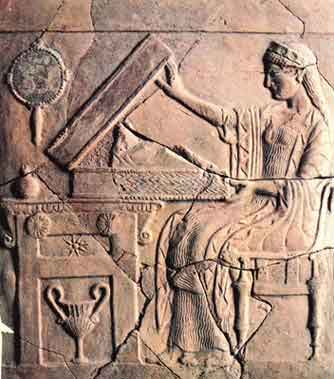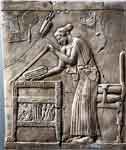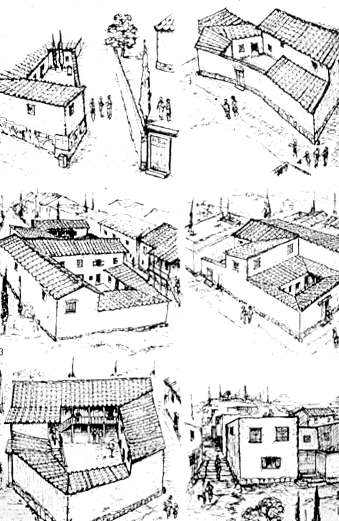|
|
Häuser und Möbel im antiken Griechenland Part 2
Oikos a Greek word for "house, habitation" from which the word ecumene is derived "the inhabited world " and economy (household management) From a Gutenberg Text File A Day in Old Athens, William Stearns Davis, Professor of Ancient History in the University of Minnesota: Chapter IV. The Athenian House and its Furnishings. 21. Following an Athenian Gentleman Homeward.--Leaving the Agora and reentering the streets the second impression of the residence districts becomes more favorable. There are a few bay trees planted from block to block; and ever and anon the monotonous house walls recede, giving space to display some temple, like the Fane of Hephestos[*] near the Market Place, its columns and pediment flashing not merely with white marble, but with the green, scarlet, and gold wherewith the Greeks did not hesitate to decorate their statuary. [*]Wrongly called the "Theseum" in modern Athens. We observe that almost the entire crowd leaving the Agora goes on foot. To ride about in a chariot is a sign of undemocratic presumption; while only women or sick men will consent to be borne in a litter. We will select a sprucely dressed gentleman who has just been anointed in a barber's shop and accompany him to his home. He is neither one of the decidedly rich, otherwise his establishment would be exceptional, not typical, nor is he of course one of the hard-working poor. Followed by perhaps two clean and capable serving lads, he wends his way down several of the narrow lanes that lie under the northern brow of the Acropolis[*]. Before a plain solid house door he halts and cries, "Pai! Pai!" ["Boy! Boy!"]. There is a rattle of bolts and bars. A low-visaged foreign-born porter, whose business it is to show a surly front to all unwelcome visitors, opens and gives a kind of salaam to his master; while the porter's huge dog jumps up barking and pawing joyously. [*]This would be a properly respectable quarter of the city, but we do not know of any really "aristocratic residence district" in Athens. As we enter behind him (carefully advancing with right foot foremost, for it is bad luck to tread a threshold with the LEFT) we notice above the lintel some such inscription as "Let no evil enter here!" or "To the Good Genius," then a few steps through a narrow passage bring us into the Aula, the central court, the indispensable feature of every typical Greek house. 22. The Type and use of a Greek House.--All domestic architecture, later investigators will discover, falls into two great categories—of the northern house and the southern house. The northern house begins with a single large room, "the great hall," then lesser rooms are added to it. It gets its light from windows in the outer walls, and it is covered by a single steep roof. The southern (Greek and Oriental) house is a building inclosing a rectangular court. The rooms, many or few, get their light from this court, while they are quite shut off from the world outside. All in all, for warm climates this style of house is far more airy, cool, comfortable than the other. The wide open court becomes the living room of the house save in very inclement weather. Socrates is reported to have uttered what was probably the average sensible view about a good house.[*] The good house, he thought, should be cool in summer, and warm in winter, convenient for the accommodation of the family and its possessions. The central rooms should therefore be lofty and should open upon the south, yet for protection in summer there should be good projecting eaves (over the court) and again the rooms on the northern exposure should be made lower. All this is mere sense, but really the average male Athenian does not care a great deal about his dwelling. He spends surprisingly little money beautifying it. Unless he is sick, he will probably be at home only for sleeping and eating. The Agora, the Public Assembly, the Jury Courts, the Gymnasium, the great religious festivals consume his entire day. "I never spend my time indoors," says Xenophon's model Athenian, "my wife is well able to run the household by herself."[+] Such being the case, even wealthy men have very simple establishments, although it is at length complained (e.g. by Demosthenes) that people are now building more luxurious houses, and are not content with the plain yet sufficient dwellings of the great age of Pericles.[@] 23. The Plan of a Greek House.--The plan of a Greek house naturally varies infinitely according to the size of the land plot, the size of the owner's family, his own taste, and wealth. It will usually be rectangular, with the narrower side toward the street; but this is not invariable. In the larger houses there will be two courts (aule), one behind the other, and each with its own circuit of dependent chambers. The court first entered will be the Andronitis (the Court of the Men), and may be even large enough to afford a considerable promenade for exercise. Around the whole of the open space run lines of simple columns, and above the opening swings an awning if the day is very hot. In the very center rises a small stone alter with a statue of Zeus the Protector (Zeus Herkeios), where the father of the family will from time to time offer sacrifice, acting as the priest for the household. Probably already on the alter there has been laid a fresh garland; if not, the newcomers from the Agora have now fetched one.
The Andronitis is the true living room of the house: here the master will receive his visitors, here the male slaves will work, and the women also busy themselves (promptly retiring, however, on the appearance of masculine strangers). The decoration is very plain: the walls are neatly tinted with some kind of wash; the floor is of simple plaster, or, in a humbler house, common earth pounded hard. Under the colonnade at all four sides open the various chambers, possibly twelve in all. They really are cells or compartments rather than rooms, small and usually lighted only by their doors. Some are used for storerooms, some for sleeping closets for the male slaves and for the grown-up sons of the house, if there are any. Dark, ill ventilated, and most scantily furnished, it is no wonder that the average Athenian loves the Agora better than his chamber. The front section of the house is now open to us, but it is time to penetrate farther. Directly behind the open court is a sizable chamber forming a passage to the inner house. This chamber is the Andron, the dining hall and probably the most pretentious room in the house. Here the guests will gather for the dinner party, and here in one corner smokes the family hearth, once the real fire for the whole household cooking, but now merely a symbol of the domestic worship. It is simply a little round alter sacred to Hestia, the hearth goddess,[*] and on its duly rekindled flame little "meat offerings and drink offerings" are cast at every meal, humble or elaborate. [*]Who corresponds to the Roman goddess Vesta. In the rear wall of the Andron facing the Andronitis is a solid door. We are privileged guests indeed if we pass it. Only the father, sons, or near male kinsmen of the family are allowed to go inside, for it leads into the Gyneconitis, the hall of the women. To thrust oneself into the Gyneconitis of even a fairly intimate friend is a studied insult at Athens, and sure to be resented by bodily chastisement, social ostracism, and a ruinous legal prosecution. The Gyneconitis is in short the Athenian's holy of holies. Their women are forbidden to participate in so much of public life that their own peculiar world is especially reserved to them. To invade this world is not bad breeding; it is social sacrilege. In the present house, the home of a well-to-do family, the Gyneconitis forms a second pillared court with adjacent rooms of substantially the same size and shape as the Andronitis. One of the rooms in the very rear is proclaimed by the clatter of pots and pans and the odor of a frying turbot to be the kitchen; others are obviously the sleeping closets of the slave women. On the side nearest to the front of the house, but opening itself upon this inner court, is at least one bed chamber of superior size. This is the Thalamos, the great bedroom of the master and mistress, and here are kept all the most costly furnishings and ornaments in the house. If there are grown-up unmarried daughters, they have another such bedroom (anti-thalamos) that is much larger than the cells of the slave girls. Another special room is set apart for the working of wool, although this chief occupation of the female part of the household is likely to be carried on in the open inner court itself, if the weather is fine. Here, around a little flower bed, slave girls are probably spinning and embroidering, young children playing or quarreling, and a tame quail is hopping about and watching for a crumb. There are in fact a great many people in a relatively small space; everything is busy, chattering, noisy, and confusing to an intruding stranger.
A relief from a Greek colony in Calabria, a woman opens a case probably with clothes, National Museum of Reggio Calabria, 490-450 BC (Image from a Greek school Project) . So called "Pinax of Persephone" opening the "Likon Mystikon". Found in the holy shrine of Persephone at Locri in the district Mannella.
Images
See also , by Bradley A. Ault (Editor), Lisa C. Nevett (Editor) University of Pennsylvania Press 2005 , ISBN 0812238753
|



